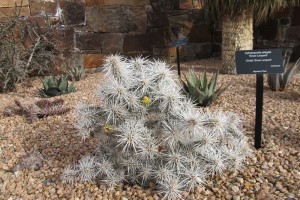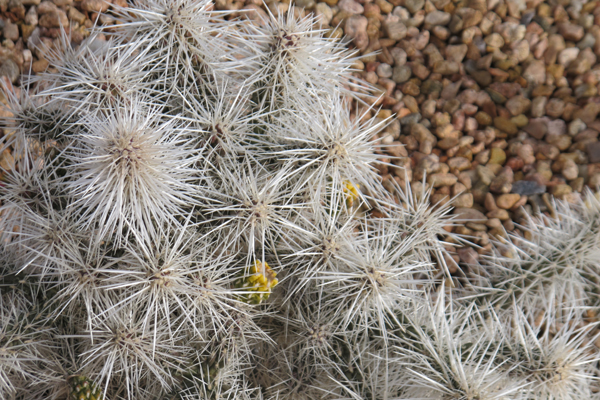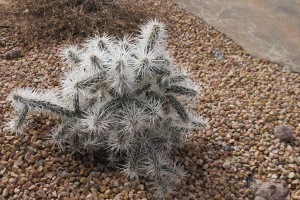Scientific name: Cylindropuntia whipplei ‘Snow Leopard’
Common Names: ‘Snow Leopard’ cholla, Whipple’s cholla
Family: Cactaceae
Article by Susan Bruneni

Cylindropuntia whipplei ‘Snow Leopard’ in the Dry Garden by Jeri Chenelle
Of the more than 20 species of cholla found in the American Southwest, the ‘Snow Leopard’ or Whipple’s cholla is among the most suitable for home gardens. It is one of several cholla species planted at Santa Fe Botanical Garden’s Museum Hill.
The ‘Snow Leopard’ is more compact than most other chollas. Spines are so white they are often described as glowing in direct light. They maintain a characteristic beauty in the winter because of the dense pale spines. Blooms are yellow/green and appear in late spring and early summer. The ‘Snow Leopard’ cholla is recommended by the Denver Botanic Garden for use in home gardens and can easily be found at local nurseries. The spines can be treacherous and need to be dealt with cautiously.
The ‘Snow Leopard’ cholla is found at elevations from 5,000-7,400 feet in Arizona, Colorado, New Mexico Nevada and Texas. Mature plants are one-to-four feet tall and two-to-three feet wide. The plant is extremely cold hardy and grows in high desert conditions on hillsides, plains and desert grasslands. In the Four Corners area and Pipe Spring National Monument in Arizona, ‘Snow Leopard’ chollas form dense, low spiny thickets which can impede grazing access for livestock.

Close up Cylindropuntia whipplei ‘Snow Leopard’ by Jeri Chenelle
Species of chollas range from ground creepers to shrubs or trees, varying in height from less than a foot (club or devil cholla) to as much as 15 feet (chain-fruit cholla).

Cylindropuntia whipplei ‘Snow Leopard’ by Jeri Chenelle
All chollas have cylindrical stem segments. Spines replace leaves. Most cholla cactus have orange or greenish-yellow flowers with a variety of colors, even among the same species. Most species bloom April through June, depending on local conditions. Stems and joints vary in width, length, shape, and color, as well as in the profusion of spines and glochids.
References:
Gardners Guide to Cactus, Scott Calhoun
Dave’s Garden.com
plants.usda.com


